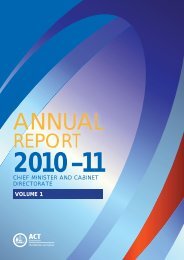Governing the City State - Chief Minister and Treasury Directorate ...
Governing the City State - Chief Minister and Treasury Directorate ...
Governing the City State - Chief Minister and Treasury Directorate ...
You also want an ePaper? Increase the reach of your titles
YUMPU automatically turns print PDFs into web optimized ePapers that Google loves.
Guiding Principles – Embracing UniquenessFrom <strong>the</strong> outset, <strong>the</strong> Review sought to develop recommendations that will result in tangible<strong>and</strong> sustainable improvements in how <strong>the</strong> ACTPS goes about its work.In approaching its consideration of improvements to <strong>the</strong> ACTPS’s effectiveness, capacity <strong>and</strong>structure, <strong>the</strong> Review adopted a principles-based approach that embraces <strong>the</strong> ACT’suniqueness. A recurring <strong>the</strong>me in consultations was that <strong>the</strong> ACTPS should stop trying to bea state government bureaucracy to which local council service delivery obligations have beenappended, <strong>and</strong> instead organise itself <strong>and</strong> operate in a way that reflects its responsibilities forproviding a range of services to <strong>the</strong> city state that it serves. The Review acknowledges that<strong>the</strong> ACTPS’s responsibilities range from collecting garbage, fixing potholes, <strong>and</strong> providinglocal libraries to running a gaol, a hospital system, <strong>and</strong> public schools. With this in mind ithas sought to arrange service delivery lines <strong>and</strong> responsibilities in a form that makes sensefrom <strong>the</strong> outside, as well as from <strong>the</strong> inside, <strong>and</strong> is coherent in <strong>the</strong> ACT context.The traditional hierarchical culture <strong>and</strong> structures inherited from <strong>the</strong> Commonwealth with <strong>the</strong>granting of self government were questioned. So was <strong>the</strong> need to mirror structures that are inplace in larger Australian <strong>State</strong> Governments simply because <strong>the</strong> ACT Government hasequivalent functions.The Review has sought to develop structures that are fit for purpose in Canberra’s city stategovernment – structures that present a coherent <strong>and</strong> consistent face to <strong>the</strong> people of Canberra<strong>and</strong> make it easy to deal with <strong>the</strong> ACTPS. There are currently pockets of leading practiceincluding Canberra Connect, but <strong>the</strong>re are also areas hampered by <strong>the</strong> desiccation ofstructures <strong>and</strong> roles, <strong>and</strong> division – ra<strong>the</strong>r than sharing – of responsibility. In part this desirefor clarity is evident in a bias in <strong>the</strong> Review’s recommendations towards fewer organisationalunits, <strong>and</strong> clear lines of accountability from those units to a single <strong>Minister</strong>. One of <strong>the</strong>challenges in this context, ultimately stemming from <strong>the</strong> Australian Capital Territory (Self-Government) Act 1988 (Cwlth) 4 , is <strong>the</strong> size of <strong>the</strong> Ministry – itself a function of <strong>the</strong> size of<strong>the</strong> Assembly – relative to <strong>the</strong> volume <strong>and</strong> breadth of <strong>the</strong> ACT Government’s responsibilities.The Review has sought to reduce fragmentation, duplication <strong>and</strong> unnecessary bureaucracy.It has proceeded on <strong>the</strong> basis that structures should be clear to <strong>the</strong> citizenry of <strong>the</strong> ACT, tostakeholder groups, <strong>and</strong> to <strong>the</strong> <strong>Minister</strong>s <strong>and</strong> officials that operate within <strong>the</strong>m on a dailybasis. There was a prevailing view among officials <strong>and</strong> stakeholders during consultationsthat <strong>the</strong> current ACTPS structures are over-engineered, resulting in fragmentation ofresponsibilities <strong>and</strong> creation of roles that are not necessarily well or commonly understood.The approach taken by <strong>the</strong> Review reflects <strong>the</strong> maturity of <strong>the</strong> ACT’s self governmentarrangements which are now over 21 years old. It is interesting to note that nei<strong>the</strong>r a singleSubmission nor a single contributor to <strong>the</strong> Review suggested that <strong>the</strong> current structures are<strong>the</strong> ones that would be built now if you were starting from a blank sheet of paper to organise4 See http://www.comlaw.gov.au/Background to <strong>the</strong> Review: 25



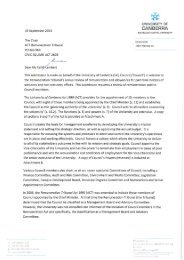
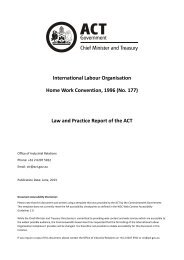
![HSR Training Programs Guidelines [ PDF 191KB]](https://img.yumpu.com/51348280/1/190x245/hsr-training-programs-guidelines-pdf-191kb.jpg?quality=85)


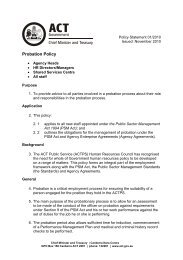



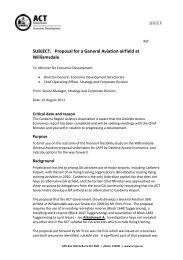
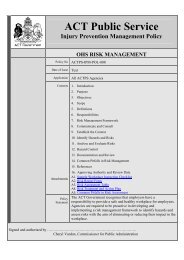
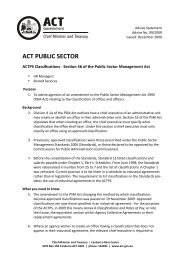
![Teachers Technical and Further Education [ PDF 68KB]](https://img.yumpu.com/34230751/1/184x260/teachers-technical-and-further-education-pdf-68kb.jpg?quality=85)
